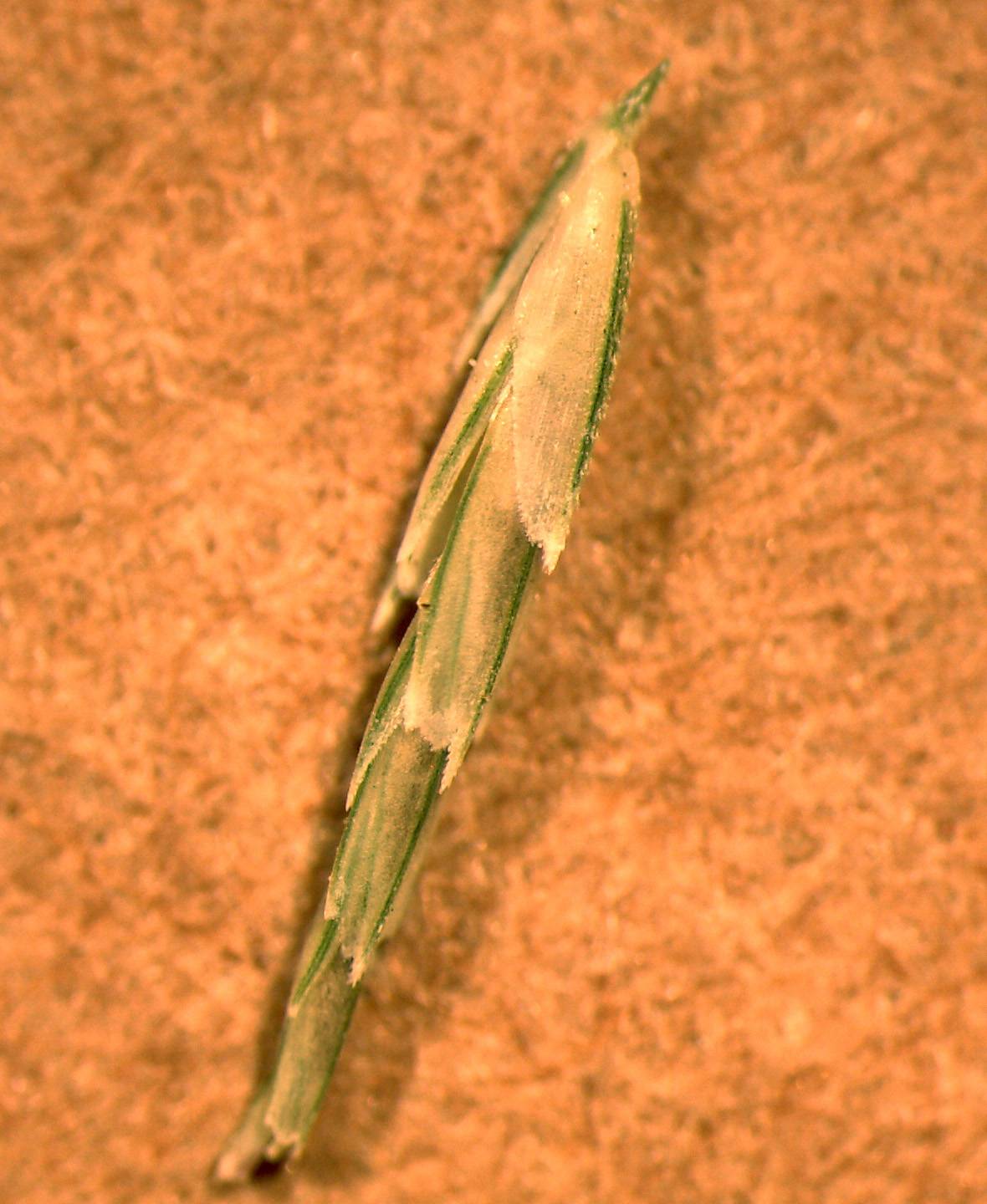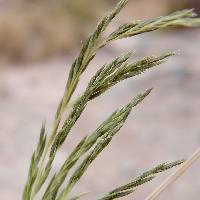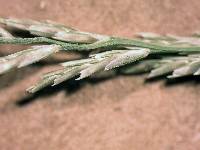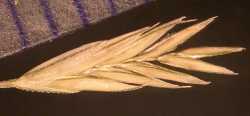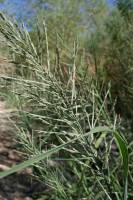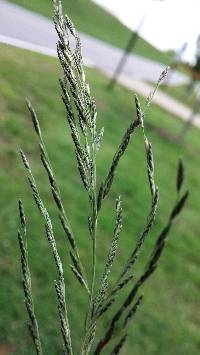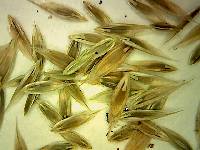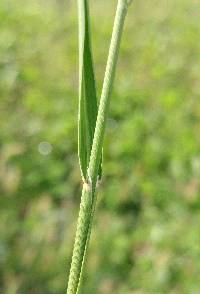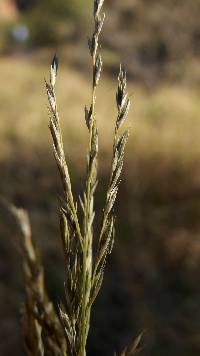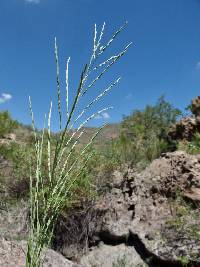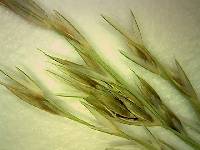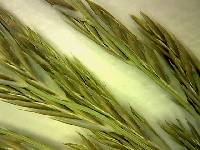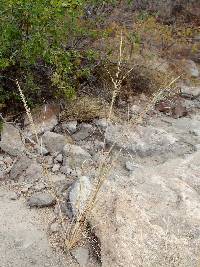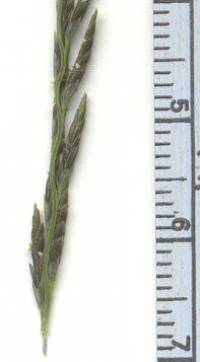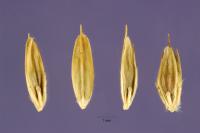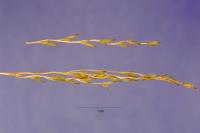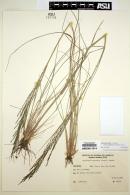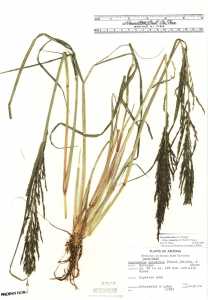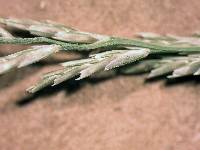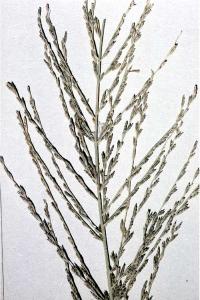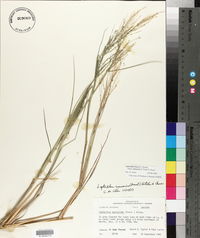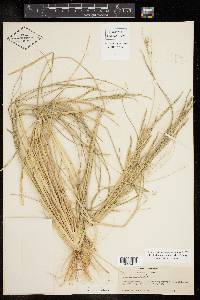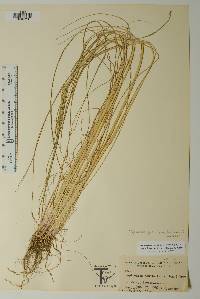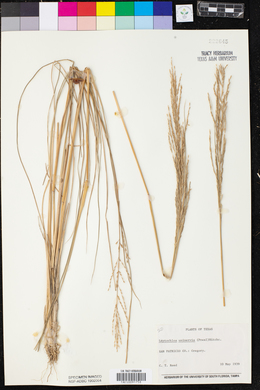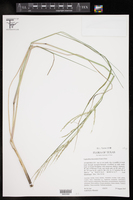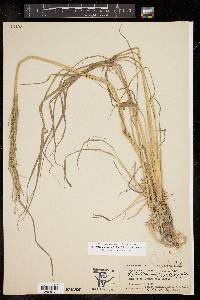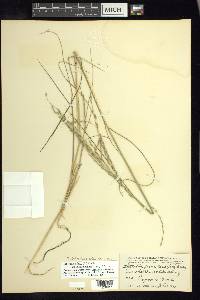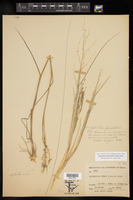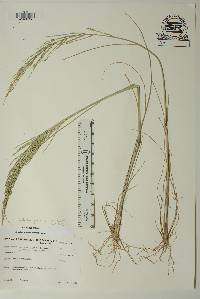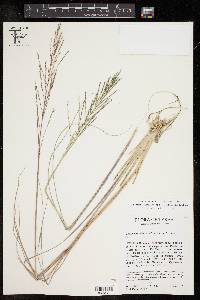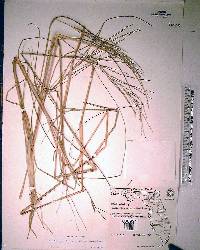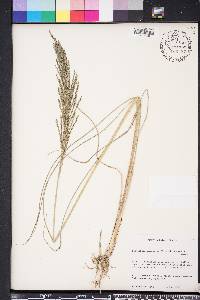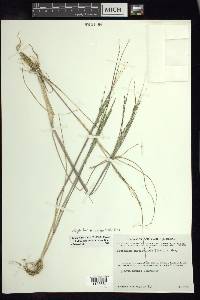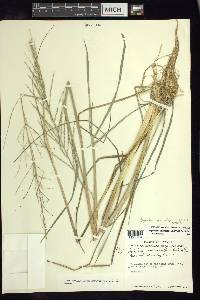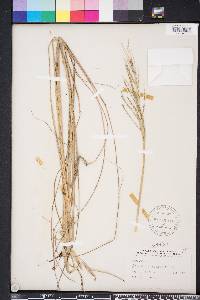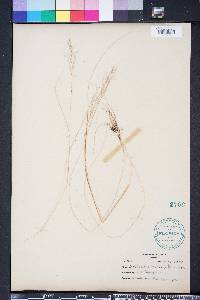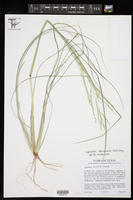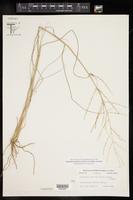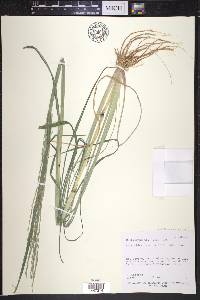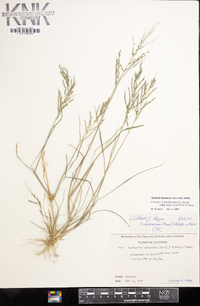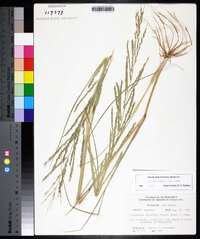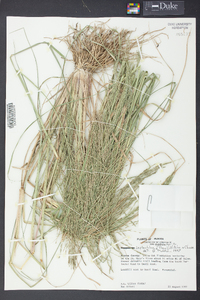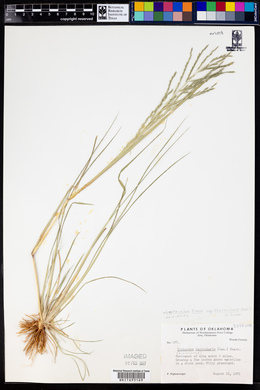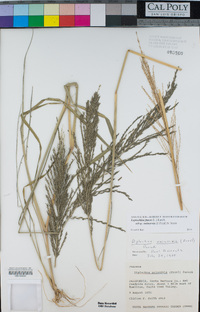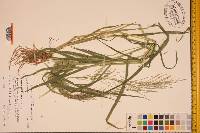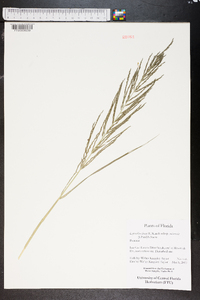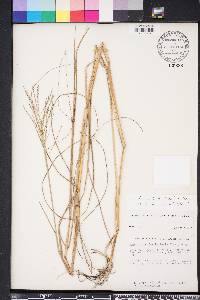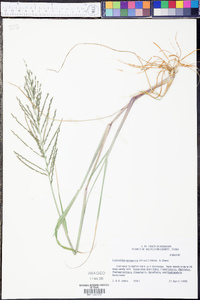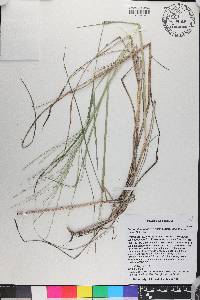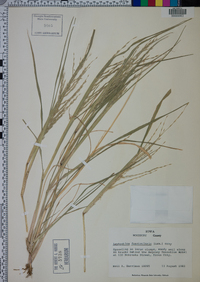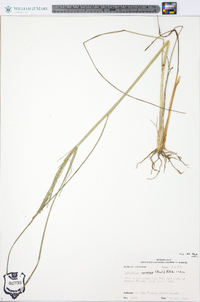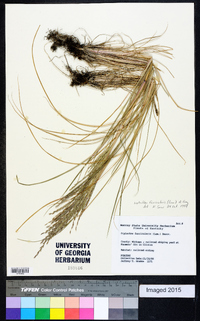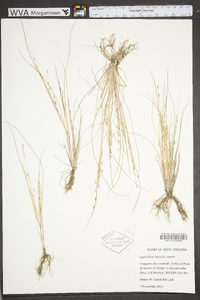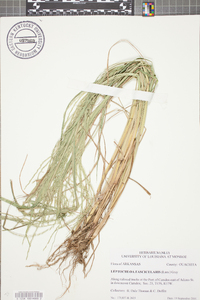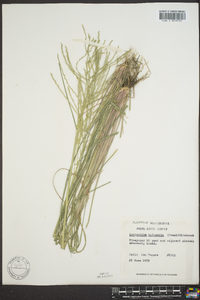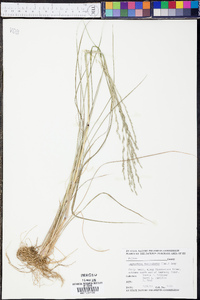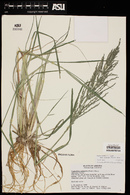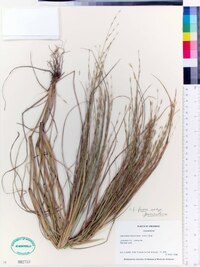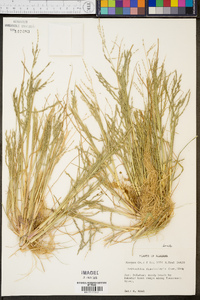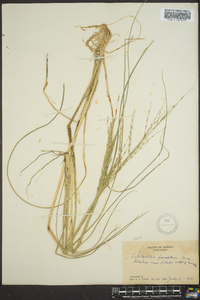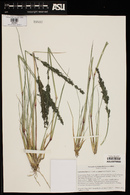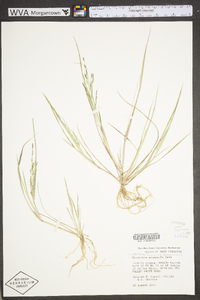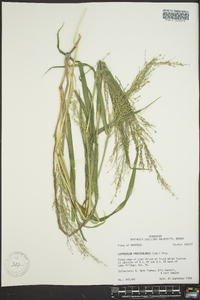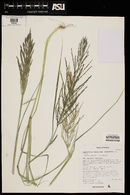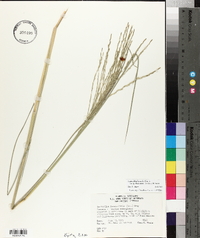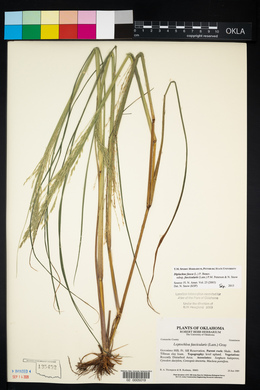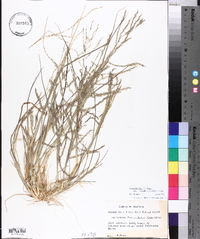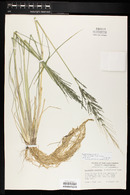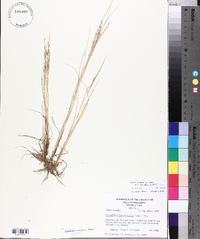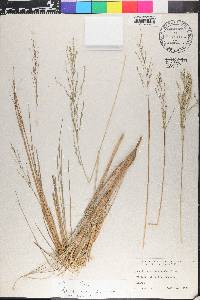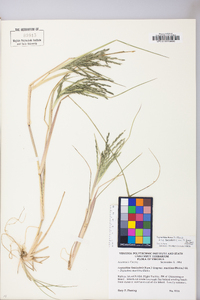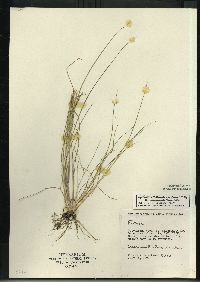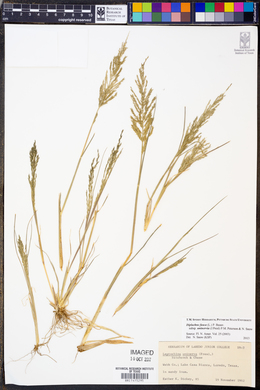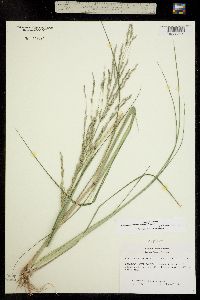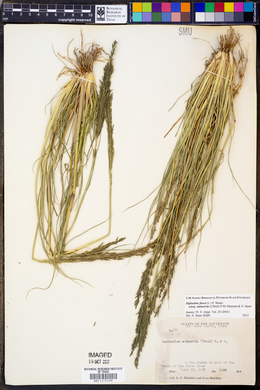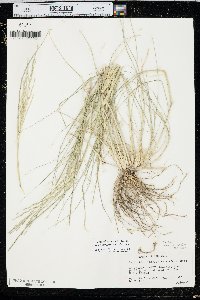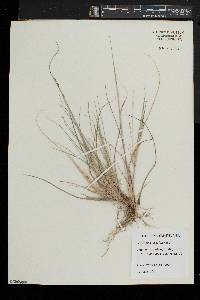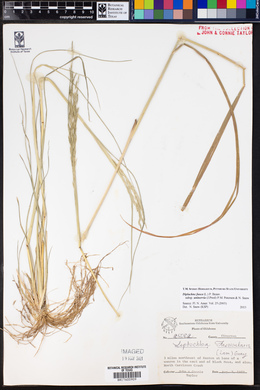
|
|
|
|
Family: Poaceae
Bearded Beetle Grass, more...Malabar sprangletop, Malabar sprangletop
[Diplachne alba Hochst., moreDiplachne fusca var. alba (Hochst.) Chiov., Leptochloa fusca (L.) Kunth, Leptochloa fusca fusca , Leptochloa neuroglossa Eichinger ex Peter, Poa malabarica L., Tridens capensis Nees, Triodia capensis (Nees) T. Durand & Schinz, Triodia livida (Nees) T. Durand & Schinz, Uralepis capensis (Nees) Steud.] |
Plants annual or weakly perennial. Culms 5-170 cm, prostrate to erect; compressed, often branching; internodes hollow. Sheaths glabrous or scabrous; ligules 2-8 mm, membranous, attenuate, becoming lacerate at maturity; blades 3-50 cm long, 2-7 mm wide, glabrous or scabrous, those of the flag leaves sometimes exceeding the panicles. Panicles (1.5)10-105 cm long, 0.5-22 cm wide, with 3-35 racemose branches, bases of the panicles sometimes remaining enclosed in the upper leaf sheaths at maturity; branches 1.5-20(22) cm, ascending to reflexed. Spikelets 5-12(14) mm, with 6-20 florets. Lower glumes 1-3(4.9) mm; upper glumes 1.8-5.5 mm; lemmas 2-6 mm, sometimes with a dark spot near the base, apices acute to truncate, sometimes emarginate to bifid, unawned, mucronate, or awned; paleas somewhat sericeous along the veins; anthers 1-3, 0.2-2.7 mm. Caryopses 0.8-2.4 mm, elliptic to ovate or obovate. 2n = 20. Leptochloa fusca grows in warm areas throughout the world. The two American subspecies, subsp. uninervia and subsp. fascicularis, are usually distinct, but they intergrade repeatedly with subsp. fusca. Dr. David Bogler, USDA NRCS PLANTS Database Perennials, Terrestrial, not aquatic, Stems nodes swollen or brittle, Stems geniculate, decumbent, or lax, sometimes rooting at nodes, Stems caespitose, tufted, or clustered, Stems terete, round in cross section, or polygonal, Stems compressed, flattened, or sulcate, Stems branching above base or distally at nodes, Stem internodes hollow, Stems with inflorescence less than 1 m tall, Stems with inflorescence 1-2 m tall, Stems, culms, or scapes exceeding basal leaves, Leaves mostly cauline, Leaves conspicuously 2-ranked, distic hous, Leaves sheathing at base, Leaf sheath mostly open, or loose, Leaf sheath smooth, glabrous, Leaf sheath and blade differentiated, Leaf blades linear, Leaf blades 2-10 mm wide, Leaf blades mostly flat, Leaf blade margins folded, involute, or conduplicate, Leaf blades mostly glabrous, Leaf blades scabrous, roughened, or wrinkled, Ligule present, Ligule an unfringed eciliate membrane, Ligule a fringed, ciliate, or lobed membrane, Inflorescence terminal, Inflorescence solitary, with 1 spike, fascicle, glomerule, head, or cluster per stem or culm, Inflorescence a panicle with narrowly racemose or spicate branches, Inflorescence branches more than 10 to numerous, Inflorescence branches 1-sided, Flowers bisexual, Spikelets sessile or subsessile, Spikelets laterally compressed, Spikelet less than 3 mm wide, Spikelets with 8-40 florets, Spikelets solitary at rachis nodes, Spikelets all alike and fertille, Spikelets bisexual, Spikelets disarticulating above the glumes, glumes per sistent, Spikelets disarticulating beneath or between the florets, Spikelets secund, in rows on one side of rachis, Rachilla or pedicel glabrous, Glumes present, empty bracts, Glumes 2 clearly present, Glumes distinctly unequal, Glumes shorter than adjacent lemma, Glumes keeled or winged, Glumes 1 nerved, Lemmas thin, chartaceous, hyaline, cartilaginous, or membranous, Lemma 3 nerved, Lemma body or surface hairy, Lemma apex dentate, 2-fid, Lemma awnless, Lemma mucronate, very shortly beaked or awned, less than 1-2 mm, Lemma straight, Palea present, well developed, Palea membranous, hyaline, Palea about equal to lemma, Palea 2 nerved or 2 keeled, Stamens 1, Stamens 2, Stamens 3, Styles 2-fid, deeply 2-branched, Stigmas 2, Fruit - caryopsis.
FNA 2003, Gould 1980 Common Name: Malabar sprangletop Duration: Annual Nativity: Native Lifeform: Graminoid General: Annual to weakly perennial grass, prostrate to erect stems 5-170 cm, compressed, often branching with hollow internodes; sheaths glabrous or scabrous. Vegetative: Blades 3-50 cm long, 2-7 mm wide, glabrous or scabrous, the flag leaves sometimes exceeding the panicles; ligules 2-8 mm, membranous, attenuate, lacerate at maturity. Inflorescence: Panicles 10-105 cm long, 0.5-22 cm wide, with 3-35 racemose branches, bases of the panicles enclosed in the upper sheaths at maturity; branches 1-20 cm, ascending to reflexed; spikelets 5-12 mm with 6-20 florets; lower glumes 1-3 mm, upper 1-6 mm, lemmas 2-6 mm, sometimes with a dark spot near the base, apices acute to truncate, sometimes emarginate, mucronate to awned; paleas sericeous along the veins. Ecology: Found on moist to marshy soils, often in alkaline soils below 5,000 ft (1524 m); flowers June-October. Distribution: Warm areas throughout the world; native to Africa, Asia, Australia, N. America, and S. America; found in every state in the US. Notes: Until very recently this taxon was placed within the genus Leptochloa. Look for it under that name even in relatively recent texts. It is a robust annual grass with noticably compressed stems where they emerge from the ground, and panicles of long spikelike branches that are often partly sheathed even at maturity. In our region there are two subspecies: ssp. uninervia and ssp. fascicularis. The former is told apart by the slightly longer anthers; the 5-10 mm spikelets; and the dark green to lead-gray lemmas which are obtuse to truncate at the tip. Subsp. fascicularis is distinguished by the panicles being partially enclosed in the upper sheath; the upper leaves which are taller than the panicle; and the mature lemmas are often smoky white with a dark spot in the basal half, with tapering tip. Another annual, Leptochloa viscida, is also found in the Sororan Desert; it has consistently short-awned lemmas (vs. frequently unawned or mucronate lemmas in L. fusca), smaller panicles, an often prostrate and much-branched growth habit, and often reddish florets (vs. L. fusca's whitish or gray florets). A halophyte, L. fusca has potential for use in bioremediation of saline soils. Ethnobotany: Used as fodder for livestock around the world. Etymology: Leptochloa is from Greek leptos, slender and chloe or chloa, grass, while fusca means dark or brown. Synonyms: Festuca fusca, Diplachne fusca, Poa fusca, Uralepis fusca Editor: SBuckley 2010, AHazelton 2015 From Flora of Indiana (1940) by Charles C. Deam Indiana Coefficient of Conservatism: C = null, non-native Wetland Indicator Status: OBL |
|
|
|

